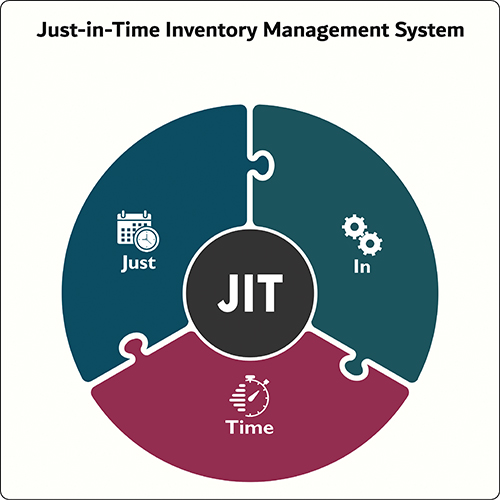Just-in-Time inventory versus Just-in-Case stockpiling: What’s the balance?
- Both approaches have strengths and weaknesses, so it’s best to use a blend of both.
- The author recommends stockpiling a small, strategic buffer of critical or specialty products, while running Just-in-Time for commodities that are easy to source.
- Digital technologies like ERP systems, AI-driven analytics and real-time inventory tracking can be used to manage this strategy.
Picture this: You’re in the middle of a high-stakes project when — Bam! — your supplier delays a shipment, and, suddenly, your production line is about as useful as a chocolate teapot. On the flip side, maybe you’ve been burned before, so you’ve stockpiled materials like a doomsday prepper, only to find that half of it is now obsolete, sitting in your warehouse like a forgotten New Year’s resolution.
Welcome to the great inventory debate: Just-in-Time (JIT) versus Just-in-Case (JIC).
In my previous article on Lean supply chains, we explored how Toyota revolutionized manufacturing efficiency with JIT, reducing waste and improving cash flow. But offsite construction isn’t quite like auto manufacturing — projects change, lead times fluctuate and weather delays are as reliable as Monday morning emails. So, the question is: How do we find the right balance?
Let’s break it down.
Just-In-Time Pros and Cons
Just-in-Time inventory sounds like a dream: order materials only when needed, keep inventory lean, free up cash and run a smooth, waste-free operation. The principle, popularized by Toyota, works brilliantly in controlled environments where supply chains are predictable, and production is standardized.

There are reasons that JIT works (in theory).
Less inventory means less warehouse space is needed. The business enjoys better cash flow because money isn’t tied up in excess stock. Materials aren’t sitting around getting damaged, outdated, or misplaced while they’re waiting to be used. And the need for timely deliveries encourages real partnerships with suppliers.
But when it comes to offsite construction, JIT can be tricky.
For one, construction material deliveries aren’t always as predictable as those of car parts. When suppliers experience delays, your entire production line suffers. The same goes for shippers: a single snowstorm or shipping delay can leave you short on the flooring you like to use and scrambling for materials.
There’s also the problem of variability. Unlike automotive manufacturing, offsite projects often have last-minute design changes, making rigid JIT ordering risky.
For instance, let’s assume that a modular housing factory switched to JIT for insulation panels, cutting storage costs by 30%. But then, winter storms in Canada delayed shipments, halting production for two weeks. The result? Delays, increased costs and some very unhappy clients.
JIT has its place, but in an industry as unpredictable as offsite construction, relying on it entirely can feel like playing supply chain roulette.
What About Just-In-Case?
Just-in-Case stockpiling takes the opposite approach: keep extra materials on hand to ensure production never stops, no matter what. It’s the equivalent of keeping extra batteries in your junk drawer — just in case.

Why does JIC work (in theory)? One advantage is that it’s a type of insurance that protects the manufacturer against delays from suppliers, ports, or raw material shortages. And last-minute design changes aren’t a problem — backup materials are at the ready. Workers aren’t standing around waiting for late shipments.
But JIC can also be tricky for offsite. While it’s nice to have lots of material on hand, warehouses aren’t free, and every square foot of stored inventory is a cost. Tying up money in excess materials can also strain budgets. And project changes can make stockpiled materials outdated, damaged, or unnecessary.
What does JIC overload look like?
A volumetric modular builder stockpiled lumber months ahead to hedge against price increases. Then, a last-minute design update required different dimensions, rendering 20% of the stock unusable. The surplus sat in storage, bleeding money and taking up space.
Clearly, too much of either strategy has its pitfalls. So, what’s the best way forward?
Finding the Sweet Spot
Rather than going all-in on JIT or JIC, the best strategy is a hybrid approach, a tailored mix based on material type, supply chain reliability and project needs.
This is Lean Buffering: just enough, but not too much. Instead of extreme JIT or JIC, keep a small, strategic buffer of critical materials while running JIT for bulkier, lower-risk items.
For instance, you might keep a buffer stock of long lead-time items like HVAC systems, specialty windows and custom-built components, while running JIT for common materials like drywall, standard framing and fasteners.

An example is a modular classroom factory that analyzed its supply chain and identified framing materials as high-risk for delays. In response, they decided to stockpile a two-week buffer while keeping other materials JIT. This reduced storage costs by 15% while preventing shutdowns.
The key to making this approach work is understanding that different materials need different inventory approaches. I recommend creating three categories:
- JIT-Friendly Materials: Easily sourced items with reliable suppliers.
- Buffered Items: Components with moderate lead times that benefit from a small safety stock.
- Stockpile Essentials: Materials with long lead times or unpredictable supply chains.
Technology can help fine-tune inventory strategies, allowing companies to shift from gut-feel ordering to data-driven decision-making.

Enterprise Resource Planning (ERP) systems can integrate supply chain production and provide procurement data for real-time visibility. IoT tracking sensors can monitor shipments, reducing the risk of surprise shortages. AI-driven forecasting can analyze past trends to predict demand and optimize ordering.
For instance, a precast concrete manufacturer used sensors to track material conditions during transit. This reduced spoilage by 15% and allowed better timing for JIT deliveries.
Real-World Examples
Here are a few lessons from the trenches:
1. Disaster-Proofing With a Backup Plan. Supply chain disruptions were causing significant delays for a prefab wall panel manufacturer. To mitigate risk, they adopted a dual-supplier strategy, working with two vendors for critical materials. Their primary supplier continues to fulfill Just-in-Time (JIT) orders, while a secondary supplier maintains a buffer stock of essential components. This approach reduces the risk of complete shutdowns and allows for a rapid response to sudden shortages. It ensures that projects stay on schedule and customers remain satisfied.
2. JIT Done Right — The Kanban Fix. A modular pod manufacturer struggled with inconsistent deliveries that were causing caused frequent production bottlenecks. To address this, they implemented a Kanban inventory system that tracks real-time usage and automatically triggers replenishment orders based on actual consumption. (For more details on Kanban, see “Improve Your Factory with Visual Management” in the June 2023 issue.)

This system eliminates the need for overstocking while ensuring that materials arrive exactly when needed. As a result, they have reduced procurement inefficiencies by 30%, freed up valuable factory space and improved workflow efficiency.
3. Strategic Buffering for Demand Fluctuations. A volumetric modular homebuilder faced unpredictable material shortages, often leading to costly rush orders. To combat this, they introduced a tiered buffering system, and now maintain minimal stock for common materials, a moderate reserve for items with fluctuating lead times and a larger inventory for critical, high-risk components. This reduced emergency procurement costs by 40% and has stabilized production schedules.
4. Leveraging AI for Smarter Inventory Management. A modular construction firm adopted AI-driven analytics to enhance its inventory strategy. By analyzing past purchasing trends, supplier reliability and seasonal fluctuations, they have optimized material ordering and can flag potential risks in advance. This has reduced overstocking by 20%, improved supplier performance and ensured their projects are never delayed due to unforeseen material shortages.
The Best Approach
The most effective inventory strategy isn’t all JIT or all JIC — it’s about balance. A hybrid approach that factors in material type, supply chain reliability and project requirements will yield the best results.
It includes keeping a strategic buffer for high-risk materials with long lead times, using technology to enhance visibility and optimize inventory flow, and working closely with suppliers to align delivery schedules and demand forecasts.
Companies that integrate both strategies benefit from greater flexibility, reduced waste and increased resilience against supply chain disruptions. Just-in-Time inventory is ideal for predictable, frequently used materials, ensuring that resources flow efficiently without unnecessary storage costs. Meanwhile, Just-in-Case stockpiling is critical for high-risk items with long lead times or unpredictable availability, preventing costly project slowdowns.
Leveraging technology — such as AI-driven analytics, ERP systems and real-time inventory tracking — can provide valuable insights, helping companies adjust their strategies dynamically. Strong supplier relationships also play a key role; collaborative partnerships enable better forecasting, smoother deliveries and enhanced supply chain stability.
Ultimately, companies that take a strategic, data-driven approach to inventory management will outperform those relying on outdated methods. By assessing risk factors, utilizing forecasting tools, and continuously refining inventory strategies, offsite construction firms can maintain efficiency while ensuring they are prepared for the unexpected.
Finding the right mix of JIT and JIC is an ongoing process, but with smart planning, offsite construction professionals can strike the perfect balance and keep their operations running smoothly — no matter what challenges arise.
At the end of the day, your inventory strategy shouldn’t feel like a high-stakes gamble. Because let’s be honest — if your approach causes more stress than a missing Allen wrench during an IKEA project, it’s time for a rethink.
Daniel Small is a Denver, Colo.-based management consultant to the offsite construction industry. He specializes in Lean Construction and Manufacturing and Six Sigma methodologies. For assistance with getting more from your offsite manufacturing process, contact him at 719-321-1953 or [email protected], or visit www.DaVinciConsulting.co.







